Chronic Illness and Disability PDF
VerifiedAdded on 2022/08/20
|9
|2531
|13
AI Summary
Contribute Materials
Your contribution can guide someone’s learning journey. Share your
documents today.
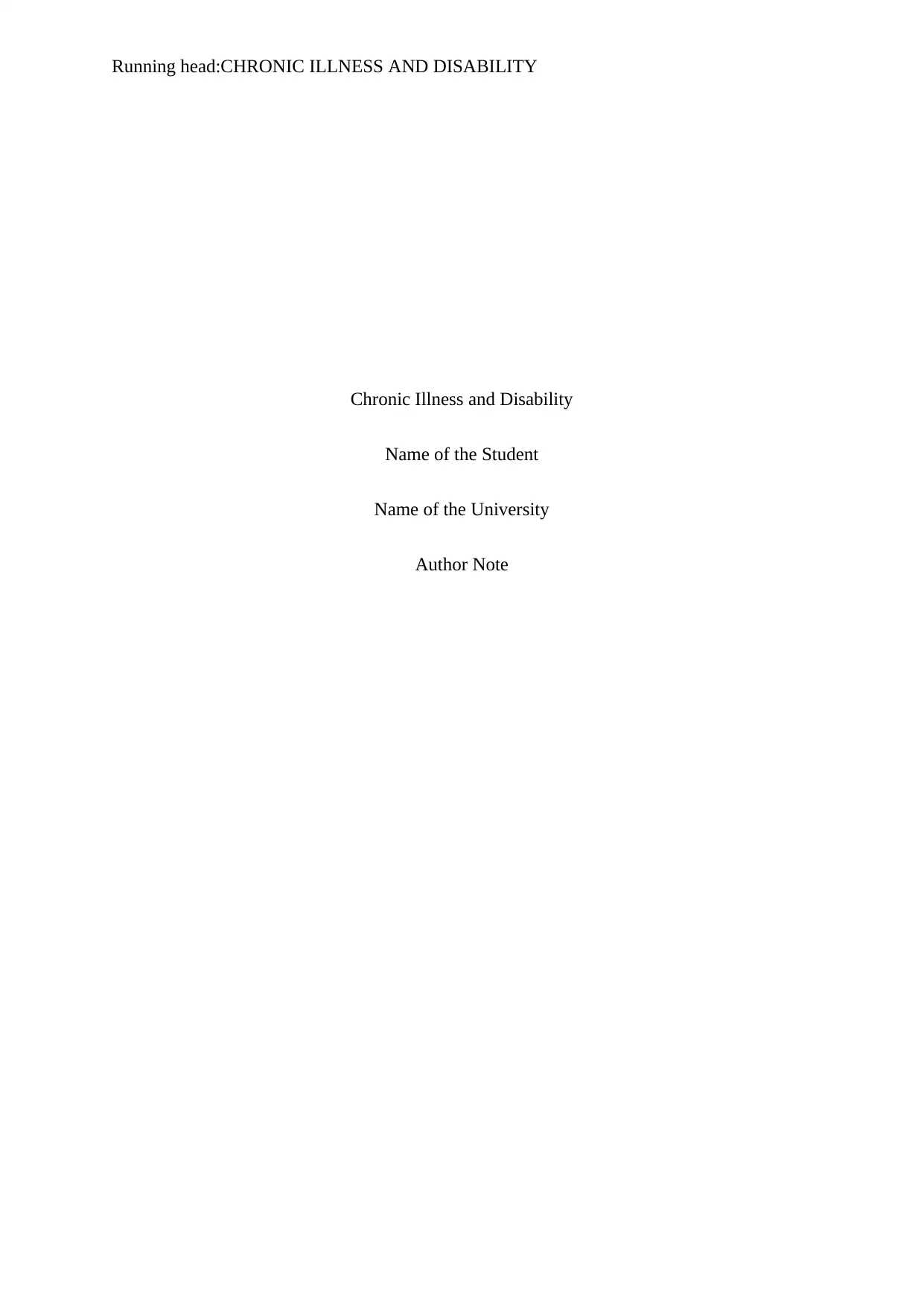
Running head:CHRONIC ILLNESS AND DISABILITY
Chronic Illness and Disability
Name of the Student
Name of the University
Author Note
Chronic Illness and Disability
Name of the Student
Name of the University
Author Note
Secure Best Marks with AI Grader
Need help grading? Try our AI Grader for instant feedback on your assignments.
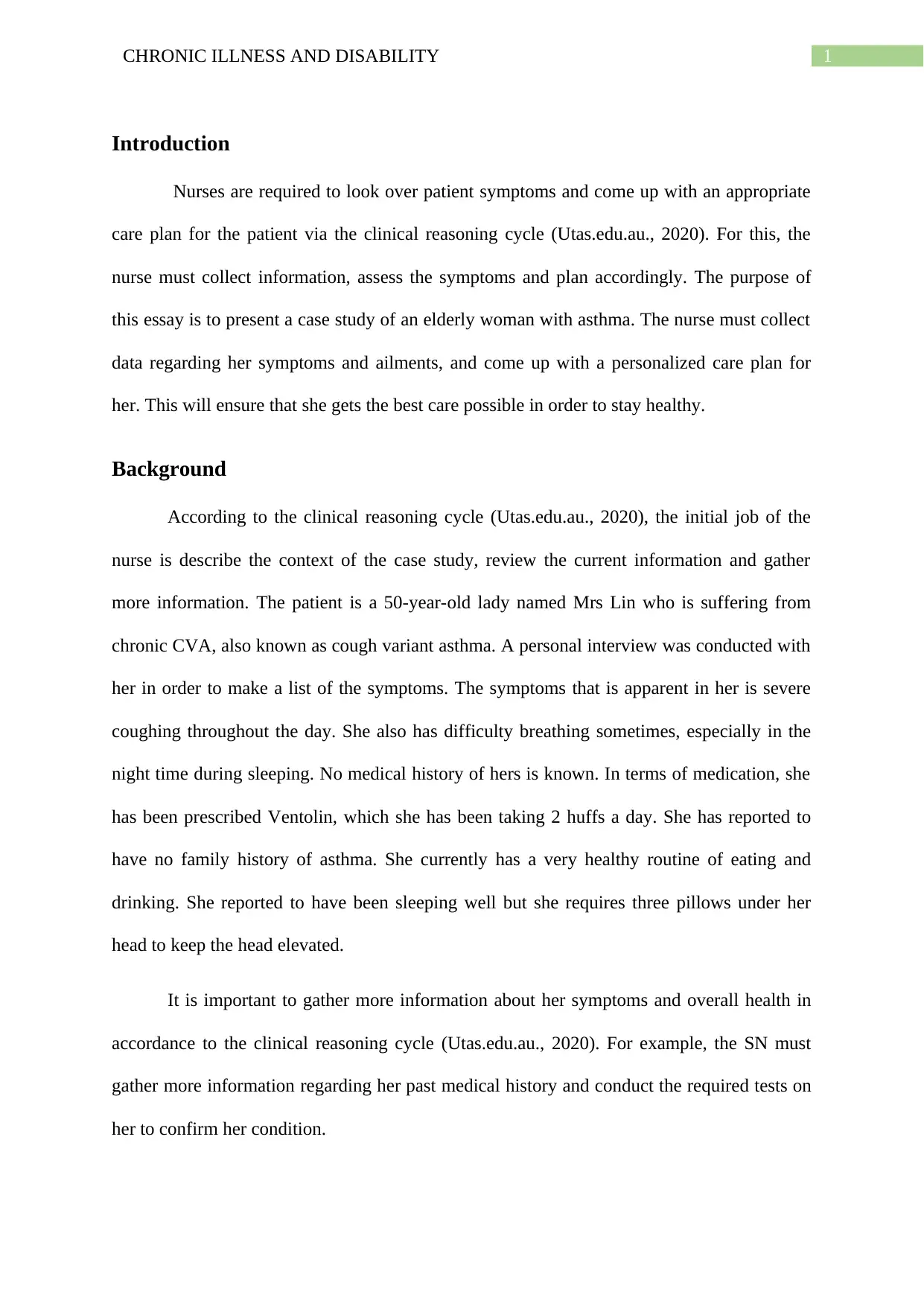
1CHRONIC ILLNESS AND DISABILITY
Introduction
Nurses are required to look over patient symptoms and come up with an appropriate
care plan for the patient via the clinical reasoning cycle (Utas.edu.au., 2020). For this, the
nurse must collect information, assess the symptoms and plan accordingly. The purpose of
this essay is to present a case study of an elderly woman with asthma. The nurse must collect
data regarding her symptoms and ailments, and come up with a personalized care plan for
her. This will ensure that she gets the best care possible in order to stay healthy.
Background
According to the clinical reasoning cycle (Utas.edu.au., 2020), the initial job of the
nurse is describe the context of the case study, review the current information and gather
more information. The patient is a 50-year-old lady named Mrs Lin who is suffering from
chronic CVA, also known as cough variant asthma. A personal interview was conducted with
her in order to make a list of the symptoms. The symptoms that is apparent in her is severe
coughing throughout the day. She also has difficulty breathing sometimes, especially in the
night time during sleeping. No medical history of hers is known. In terms of medication, she
has been prescribed Ventolin, which she has been taking 2 huffs a day. She has reported to
have no family history of asthma. She currently has a very healthy routine of eating and
drinking. She reported to have been sleeping well but she requires three pillows under her
head to keep the head elevated.
It is important to gather more information about her symptoms and overall health in
accordance to the clinical reasoning cycle (Utas.edu.au., 2020). For example, the SN must
gather more information regarding her past medical history and conduct the required tests on
her to confirm her condition.
Introduction
Nurses are required to look over patient symptoms and come up with an appropriate
care plan for the patient via the clinical reasoning cycle (Utas.edu.au., 2020). For this, the
nurse must collect information, assess the symptoms and plan accordingly. The purpose of
this essay is to present a case study of an elderly woman with asthma. The nurse must collect
data regarding her symptoms and ailments, and come up with a personalized care plan for
her. This will ensure that she gets the best care possible in order to stay healthy.
Background
According to the clinical reasoning cycle (Utas.edu.au., 2020), the initial job of the
nurse is describe the context of the case study, review the current information and gather
more information. The patient is a 50-year-old lady named Mrs Lin who is suffering from
chronic CVA, also known as cough variant asthma. A personal interview was conducted with
her in order to make a list of the symptoms. The symptoms that is apparent in her is severe
coughing throughout the day. She also has difficulty breathing sometimes, especially in the
night time during sleeping. No medical history of hers is known. In terms of medication, she
has been prescribed Ventolin, which she has been taking 2 huffs a day. She has reported to
have no family history of asthma. She currently has a very healthy routine of eating and
drinking. She reported to have been sleeping well but she requires three pillows under her
head to keep the head elevated.
It is important to gather more information about her symptoms and overall health in
accordance to the clinical reasoning cycle (Utas.edu.au., 2020). For example, the SN must
gather more information regarding her past medical history and conduct the required tests on
her to confirm her condition.
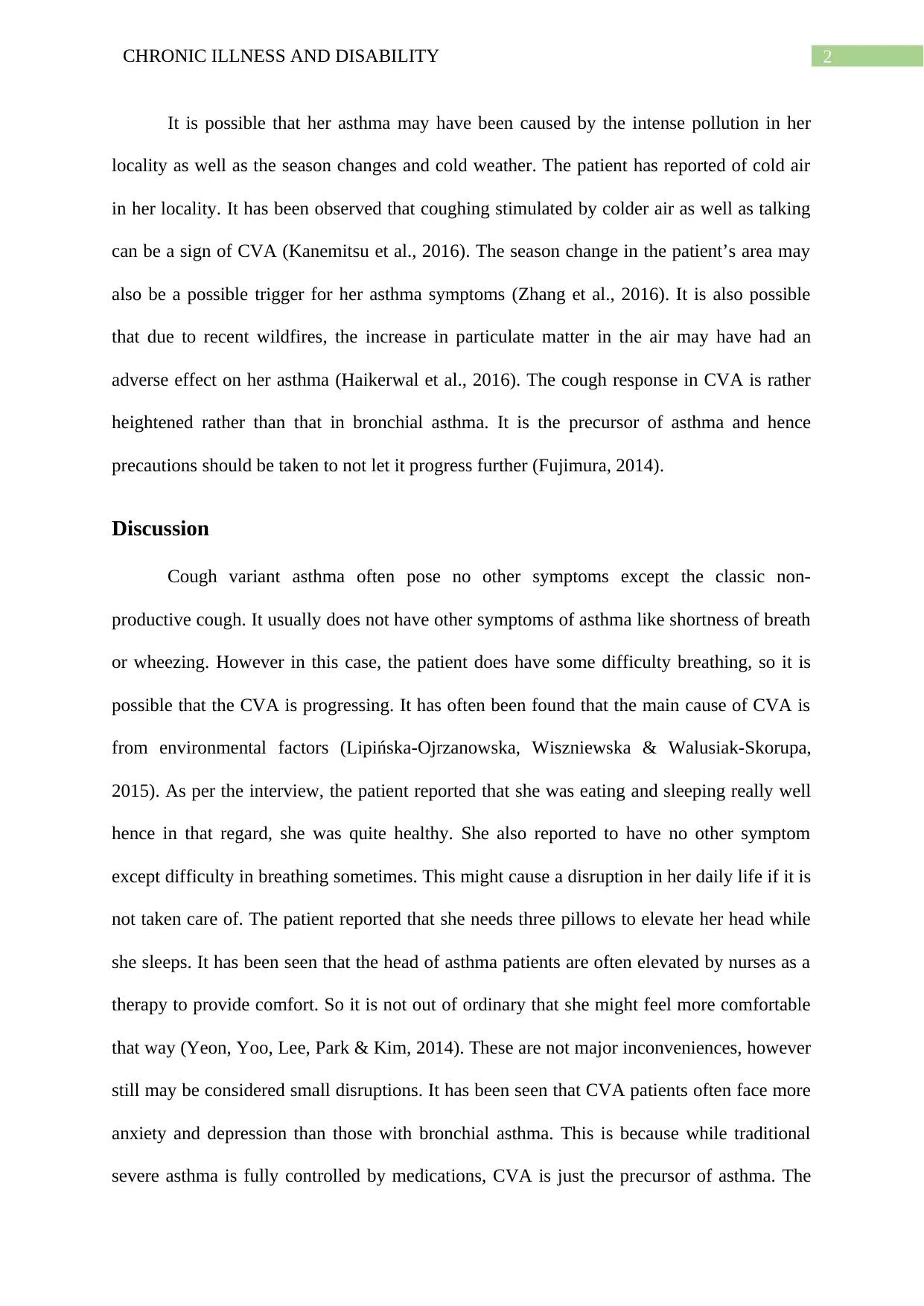
2CHRONIC ILLNESS AND DISABILITY
It is possible that her asthma may have been caused by the intense pollution in her
locality as well as the season changes and cold weather. The patient has reported of cold air
in her locality. It has been observed that coughing stimulated by colder air as well as talking
can be a sign of CVA (Kanemitsu et al., 2016). The season change in the patient’s area may
also be a possible trigger for her asthma symptoms (Zhang et al., 2016). It is also possible
that due to recent wildfires, the increase in particulate matter in the air may have had an
adverse effect on her asthma (Haikerwal et al., 2016). The cough response in CVA is rather
heightened rather than that in bronchial asthma. It is the precursor of asthma and hence
precautions should be taken to not let it progress further (Fujimura, 2014).
Discussion
Cough variant asthma often pose no other symptoms except the classic non-
productive cough. It usually does not have other symptoms of asthma like shortness of breath
or wheezing. However in this case, the patient does have some difficulty breathing, so it is
possible that the CVA is progressing. It has often been found that the main cause of CVA is
from environmental factors (Lipińska-Ojrzanowska, Wiszniewska & Walusiak-Skorupa,
2015). As per the interview, the patient reported that she was eating and sleeping really well
hence in that regard, she was quite healthy. She also reported to have no other symptom
except difficulty in breathing sometimes. This might cause a disruption in her daily life if it is
not taken care of. The patient reported that she needs three pillows to elevate her head while
she sleeps. It has been seen that the head of asthma patients are often elevated by nurses as a
therapy to provide comfort. So it is not out of ordinary that she might feel more comfortable
that way (Yeon, Yoo, Lee, Park & Kim, 2014). These are not major inconveniences, however
still may be considered small disruptions. It has been seen that CVA patients often face more
anxiety and depression than those with bronchial asthma. This is because while traditional
severe asthma is fully controlled by medications, CVA is just the precursor of asthma. The
It is possible that her asthma may have been caused by the intense pollution in her
locality as well as the season changes and cold weather. The patient has reported of cold air
in her locality. It has been observed that coughing stimulated by colder air as well as talking
can be a sign of CVA (Kanemitsu et al., 2016). The season change in the patient’s area may
also be a possible trigger for her asthma symptoms (Zhang et al., 2016). It is also possible
that due to recent wildfires, the increase in particulate matter in the air may have had an
adverse effect on her asthma (Haikerwal et al., 2016). The cough response in CVA is rather
heightened rather than that in bronchial asthma. It is the precursor of asthma and hence
precautions should be taken to not let it progress further (Fujimura, 2014).
Discussion
Cough variant asthma often pose no other symptoms except the classic non-
productive cough. It usually does not have other symptoms of asthma like shortness of breath
or wheezing. However in this case, the patient does have some difficulty breathing, so it is
possible that the CVA is progressing. It has often been found that the main cause of CVA is
from environmental factors (Lipińska-Ojrzanowska, Wiszniewska & Walusiak-Skorupa,
2015). As per the interview, the patient reported that she was eating and sleeping really well
hence in that regard, she was quite healthy. She also reported to have no other symptom
except difficulty in breathing sometimes. This might cause a disruption in her daily life if it is
not taken care of. The patient reported that she needs three pillows to elevate her head while
she sleeps. It has been seen that the head of asthma patients are often elevated by nurses as a
therapy to provide comfort. So it is not out of ordinary that she might feel more comfortable
that way (Yeon, Yoo, Lee, Park & Kim, 2014). These are not major inconveniences, however
still may be considered small disruptions. It has been seen that CVA patients often face more
anxiety and depression than those with bronchial asthma. This is because while traditional
severe asthma is fully controlled by medications, CVA is just the precursor of asthma. The
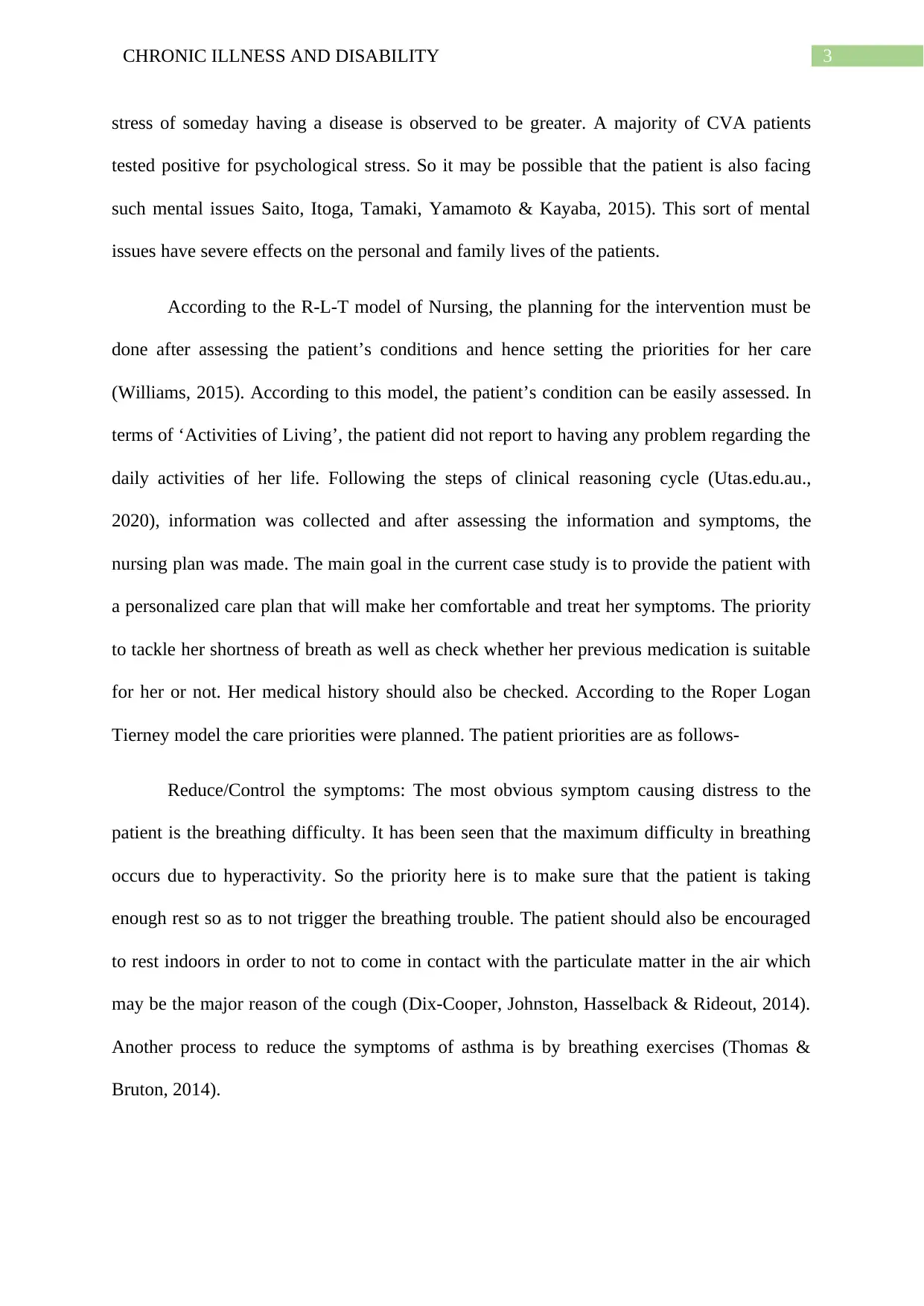
3CHRONIC ILLNESS AND DISABILITY
stress of someday having a disease is observed to be greater. A majority of CVA patients
tested positive for psychological stress. So it may be possible that the patient is also facing
such mental issues Saito, Itoga, Tamaki, Yamamoto & Kayaba, 2015). This sort of mental
issues have severe effects on the personal and family lives of the patients.
According to the R-L-T model of Nursing, the planning for the intervention must be
done after assessing the patient’s conditions and hence setting the priorities for her care
(Williams, 2015). According to this model, the patient’s condition can be easily assessed. In
terms of ‘Activities of Living’, the patient did not report to having any problem regarding the
daily activities of her life. Following the steps of clinical reasoning cycle (Utas.edu.au.,
2020), information was collected and after assessing the information and symptoms, the
nursing plan was made. The main goal in the current case study is to provide the patient with
a personalized care plan that will make her comfortable and treat her symptoms. The priority
to tackle her shortness of breath as well as check whether her previous medication is suitable
for her or not. Her medical history should also be checked. According to the Roper Logan
Tierney model the care priorities were planned. The patient priorities are as follows-
Reduce/Control the symptoms: The most obvious symptom causing distress to the
patient is the breathing difficulty. It has been seen that the maximum difficulty in breathing
occurs due to hyperactivity. So the priority here is to make sure that the patient is taking
enough rest so as to not trigger the breathing trouble. The patient should also be encouraged
to rest indoors in order to not to come in contact with the particulate matter in the air which
may be the major reason of the cough (Dix-Cooper, Johnston, Hasselback & Rideout, 2014).
Another process to reduce the symptoms of asthma is by breathing exercises (Thomas &
Bruton, 2014).
stress of someday having a disease is observed to be greater. A majority of CVA patients
tested positive for psychological stress. So it may be possible that the patient is also facing
such mental issues Saito, Itoga, Tamaki, Yamamoto & Kayaba, 2015). This sort of mental
issues have severe effects on the personal and family lives of the patients.
According to the R-L-T model of Nursing, the planning for the intervention must be
done after assessing the patient’s conditions and hence setting the priorities for her care
(Williams, 2015). According to this model, the patient’s condition can be easily assessed. In
terms of ‘Activities of Living’, the patient did not report to having any problem regarding the
daily activities of her life. Following the steps of clinical reasoning cycle (Utas.edu.au.,
2020), information was collected and after assessing the information and symptoms, the
nursing plan was made. The main goal in the current case study is to provide the patient with
a personalized care plan that will make her comfortable and treat her symptoms. The priority
to tackle her shortness of breath as well as check whether her previous medication is suitable
for her or not. Her medical history should also be checked. According to the Roper Logan
Tierney model the care priorities were planned. The patient priorities are as follows-
Reduce/Control the symptoms: The most obvious symptom causing distress to the
patient is the breathing difficulty. It has been seen that the maximum difficulty in breathing
occurs due to hyperactivity. So the priority here is to make sure that the patient is taking
enough rest so as to not trigger the breathing trouble. The patient should also be encouraged
to rest indoors in order to not to come in contact with the particulate matter in the air which
may be the major reason of the cough (Dix-Cooper, Johnston, Hasselback & Rideout, 2014).
Another process to reduce the symptoms of asthma is by breathing exercises (Thomas &
Bruton, 2014).
Secure Best Marks with AI Grader
Need help grading? Try our AI Grader for instant feedback on your assignments.
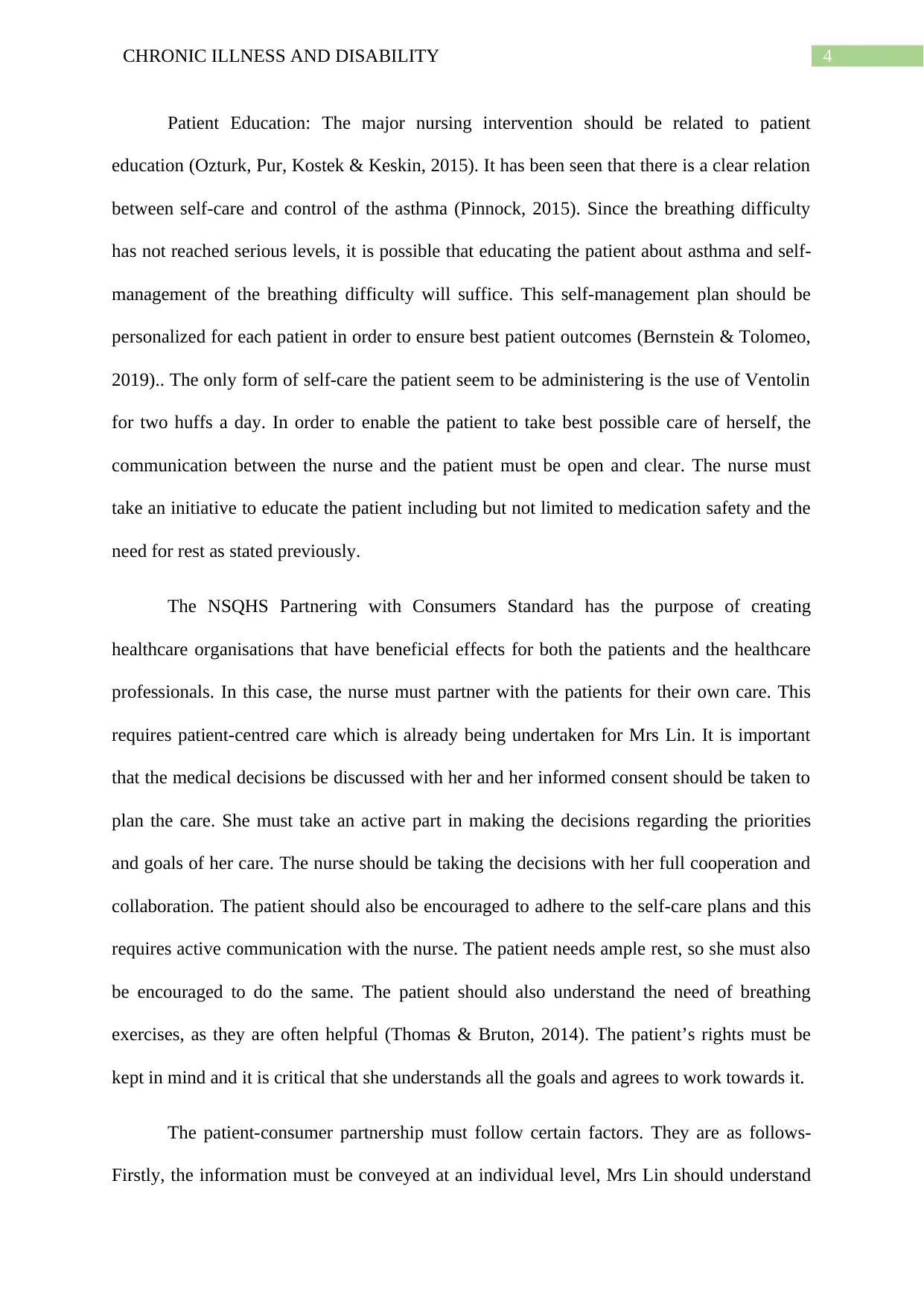
4CHRONIC ILLNESS AND DISABILITY
Patient Education: The major nursing intervention should be related to patient
education (Ozturk, Pur, Kostek & Keskin, 2015). It has been seen that there is a clear relation
between self-care and control of the asthma (Pinnock, 2015). Since the breathing difficulty
has not reached serious levels, it is possible that educating the patient about asthma and self-
management of the breathing difficulty will suffice. This self-management plan should be
personalized for each patient in order to ensure best patient outcomes (Bernstein & Tolomeo,
2019).. The only form of self-care the patient seem to be administering is the use of Ventolin
for two huffs a day. In order to enable the patient to take best possible care of herself, the
communication between the nurse and the patient must be open and clear. The nurse must
take an initiative to educate the patient including but not limited to medication safety and the
need for rest as stated previously.
The NSQHS Partnering with Consumers Standard has the purpose of creating
healthcare organisations that have beneficial effects for both the patients and the healthcare
professionals. In this case, the nurse must partner with the patients for their own care. This
requires patient-centred care which is already being undertaken for Mrs Lin. It is important
that the medical decisions be discussed with her and her informed consent should be taken to
plan the care. She must take an active part in making the decisions regarding the priorities
and goals of her care. The nurse should be taking the decisions with her full cooperation and
collaboration. The patient should also be encouraged to adhere to the self-care plans and this
requires active communication with the nurse. The patient needs ample rest, so she must also
be encouraged to do the same. The patient should also understand the need of breathing
exercises, as they are often helpful (Thomas & Bruton, 2014). The patient’s rights must be
kept in mind and it is critical that she understands all the goals and agrees to work towards it.
The patient-consumer partnership must follow certain factors. They are as follows-
Firstly, the information must be conveyed at an individual level, Mrs Lin should understand
Patient Education: The major nursing intervention should be related to patient
education (Ozturk, Pur, Kostek & Keskin, 2015). It has been seen that there is a clear relation
between self-care and control of the asthma (Pinnock, 2015). Since the breathing difficulty
has not reached serious levels, it is possible that educating the patient about asthma and self-
management of the breathing difficulty will suffice. This self-management plan should be
personalized for each patient in order to ensure best patient outcomes (Bernstein & Tolomeo,
2019).. The only form of self-care the patient seem to be administering is the use of Ventolin
for two huffs a day. In order to enable the patient to take best possible care of herself, the
communication between the nurse and the patient must be open and clear. The nurse must
take an initiative to educate the patient including but not limited to medication safety and the
need for rest as stated previously.
The NSQHS Partnering with Consumers Standard has the purpose of creating
healthcare organisations that have beneficial effects for both the patients and the healthcare
professionals. In this case, the nurse must partner with the patients for their own care. This
requires patient-centred care which is already being undertaken for Mrs Lin. It is important
that the medical decisions be discussed with her and her informed consent should be taken to
plan the care. She must take an active part in making the decisions regarding the priorities
and goals of her care. The nurse should be taking the decisions with her full cooperation and
collaboration. The patient should also be encouraged to adhere to the self-care plans and this
requires active communication with the nurse. The patient needs ample rest, so she must also
be encouraged to do the same. The patient should also understand the need of breathing
exercises, as they are often helpful (Thomas & Bruton, 2014). The patient’s rights must be
kept in mind and it is critical that she understands all the goals and agrees to work towards it.
The patient-consumer partnership must follow certain factors. They are as follows-
Firstly, the information must be conveyed at an individual level, Mrs Lin should understand
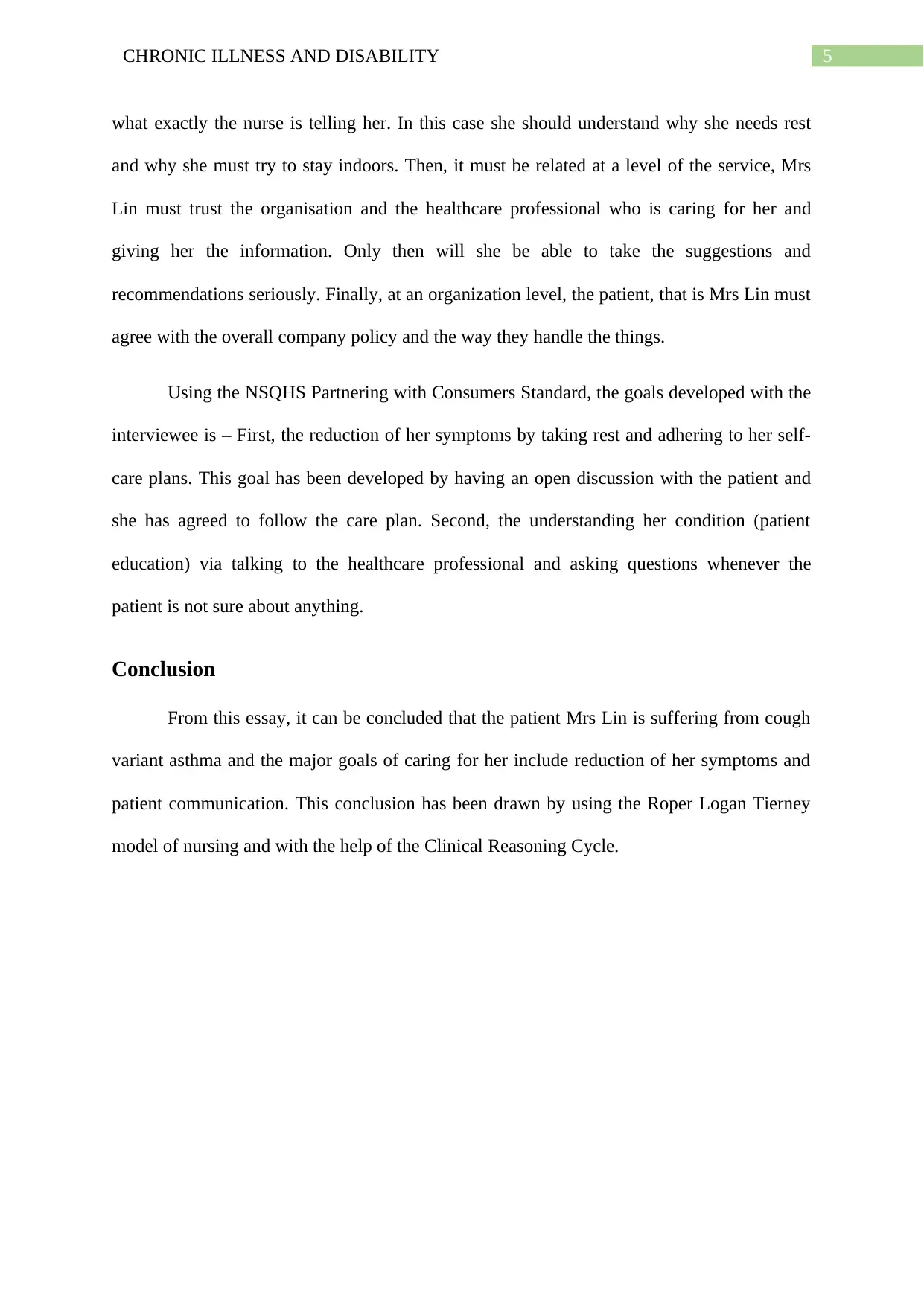
5CHRONIC ILLNESS AND DISABILITY
what exactly the nurse is telling her. In this case she should understand why she needs rest
and why she must try to stay indoors. Then, it must be related at a level of the service, Mrs
Lin must trust the organisation and the healthcare professional who is caring for her and
giving her the information. Only then will she be able to take the suggestions and
recommendations seriously. Finally, at an organization level, the patient, that is Mrs Lin must
agree with the overall company policy and the way they handle the things.
Using the NSQHS Partnering with Consumers Standard, the goals developed with the
interviewee is – First, the reduction of her symptoms by taking rest and adhering to her self-
care plans. This goal has been developed by having an open discussion with the patient and
she has agreed to follow the care plan. Second, the understanding her condition (patient
education) via talking to the healthcare professional and asking questions whenever the
patient is not sure about anything.
Conclusion
From this essay, it can be concluded that the patient Mrs Lin is suffering from cough
variant asthma and the major goals of caring for her include reduction of her symptoms and
patient communication. This conclusion has been drawn by using the Roper Logan Tierney
model of nursing and with the help of the Clinical Reasoning Cycle.
what exactly the nurse is telling her. In this case she should understand why she needs rest
and why she must try to stay indoors. Then, it must be related at a level of the service, Mrs
Lin must trust the organisation and the healthcare professional who is caring for her and
giving her the information. Only then will she be able to take the suggestions and
recommendations seriously. Finally, at an organization level, the patient, that is Mrs Lin must
agree with the overall company policy and the way they handle the things.
Using the NSQHS Partnering with Consumers Standard, the goals developed with the
interviewee is – First, the reduction of her symptoms by taking rest and adhering to her self-
care plans. This goal has been developed by having an open discussion with the patient and
she has agreed to follow the care plan. Second, the understanding her condition (patient
education) via talking to the healthcare professional and asking questions whenever the
patient is not sure about anything.
Conclusion
From this essay, it can be concluded that the patient Mrs Lin is suffering from cough
variant asthma and the major goals of caring for her include reduction of her symptoms and
patient communication. This conclusion has been drawn by using the Roper Logan Tierney
model of nursing and with the help of the Clinical Reasoning Cycle.
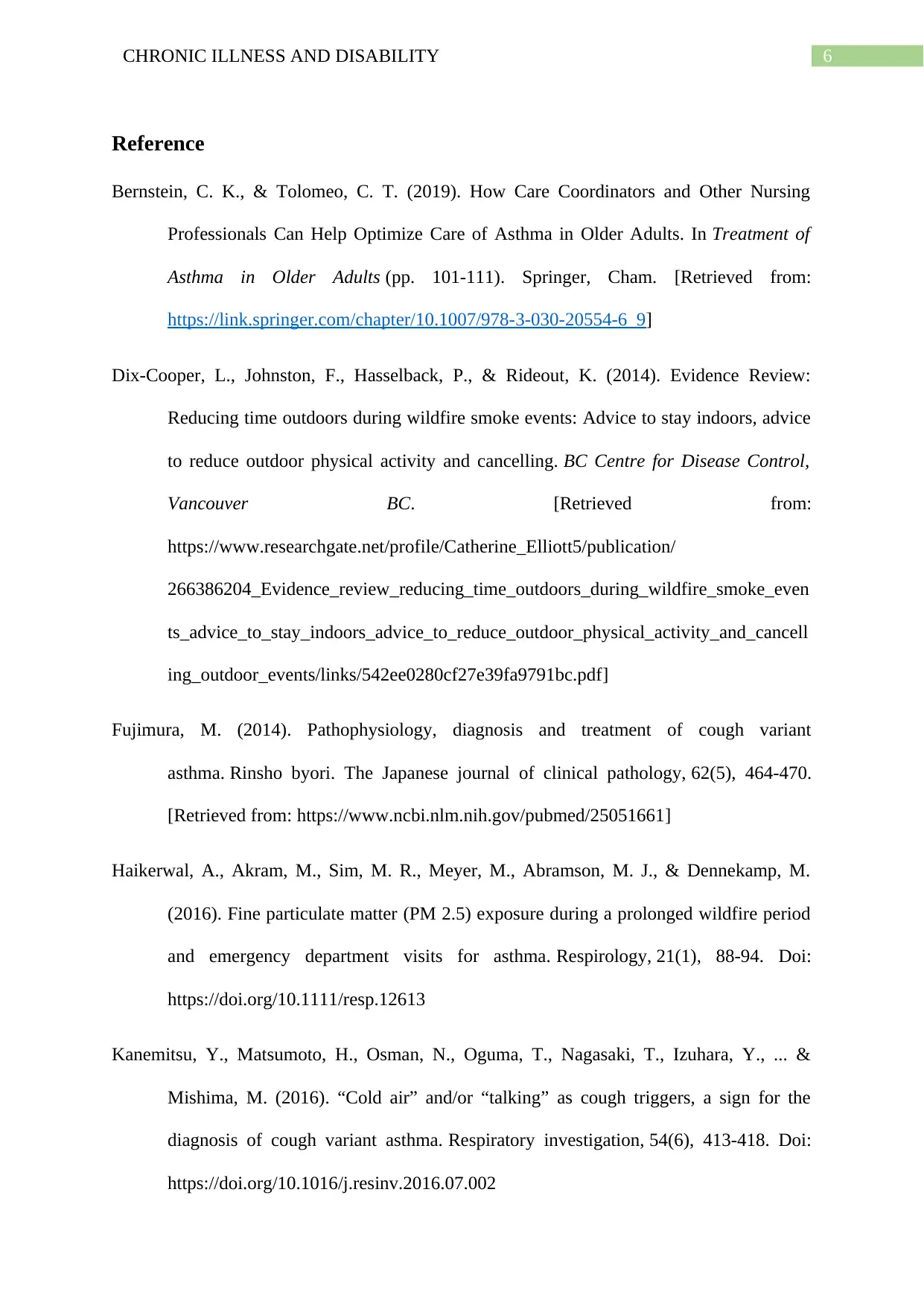
6CHRONIC ILLNESS AND DISABILITY
Reference
Bernstein, C. K., & Tolomeo, C. T. (2019). How Care Coordinators and Other Nursing
Professionals Can Help Optimize Care of Asthma in Older Adults. In Treatment of
Asthma in Older Adults (pp. 101-111). Springer, Cham. [Retrieved from:
https://link.springer.com/chapter/10.1007/978-3-030-20554-6_9]
Dix-Cooper, L., Johnston, F., Hasselback, P., & Rideout, K. (2014). Evidence Review:
Reducing time outdoors during wildfire smoke events: Advice to stay indoors, advice
to reduce outdoor physical activity and cancelling. BC Centre for Disease Control,
Vancouver BC. [Retrieved from:
https://www.researchgate.net/profile/Catherine_Elliott5/publication/
266386204_Evidence_review_reducing_time_outdoors_during_wildfire_smoke_even
ts_advice_to_stay_indoors_advice_to_reduce_outdoor_physical_activity_and_cancell
ing_outdoor_events/links/542ee0280cf27e39fa9791bc.pdf]
Fujimura, M. (2014). Pathophysiology, diagnosis and treatment of cough variant
asthma. Rinsho byori. The Japanese journal of clinical pathology, 62(5), 464-470.
[Retrieved from: https://www.ncbi.nlm.nih.gov/pubmed/25051661]
Haikerwal, A., Akram, M., Sim, M. R., Meyer, M., Abramson, M. J., & Dennekamp, M.
(2016). Fine particulate matter (PM 2.5) exposure during a prolonged wildfire period
and emergency department visits for asthma. Respirology, 21(1), 88-94. Doi:
https://doi.org/10.1111/resp.12613
Kanemitsu, Y., Matsumoto, H., Osman, N., Oguma, T., Nagasaki, T., Izuhara, Y., ... &
Mishima, M. (2016). “Cold air” and/or “talking” as cough triggers, a sign for the
diagnosis of cough variant asthma. Respiratory investigation, 54(6), 413-418. Doi:
https://doi.org/10.1016/j.resinv.2016.07.002
Reference
Bernstein, C. K., & Tolomeo, C. T. (2019). How Care Coordinators and Other Nursing
Professionals Can Help Optimize Care of Asthma in Older Adults. In Treatment of
Asthma in Older Adults (pp. 101-111). Springer, Cham. [Retrieved from:
https://link.springer.com/chapter/10.1007/978-3-030-20554-6_9]
Dix-Cooper, L., Johnston, F., Hasselback, P., & Rideout, K. (2014). Evidence Review:
Reducing time outdoors during wildfire smoke events: Advice to stay indoors, advice
to reduce outdoor physical activity and cancelling. BC Centre for Disease Control,
Vancouver BC. [Retrieved from:
https://www.researchgate.net/profile/Catherine_Elliott5/publication/
266386204_Evidence_review_reducing_time_outdoors_during_wildfire_smoke_even
ts_advice_to_stay_indoors_advice_to_reduce_outdoor_physical_activity_and_cancell
ing_outdoor_events/links/542ee0280cf27e39fa9791bc.pdf]
Fujimura, M. (2014). Pathophysiology, diagnosis and treatment of cough variant
asthma. Rinsho byori. The Japanese journal of clinical pathology, 62(5), 464-470.
[Retrieved from: https://www.ncbi.nlm.nih.gov/pubmed/25051661]
Haikerwal, A., Akram, M., Sim, M. R., Meyer, M., Abramson, M. J., & Dennekamp, M.
(2016). Fine particulate matter (PM 2.5) exposure during a prolonged wildfire period
and emergency department visits for asthma. Respirology, 21(1), 88-94. Doi:
https://doi.org/10.1111/resp.12613
Kanemitsu, Y., Matsumoto, H., Osman, N., Oguma, T., Nagasaki, T., Izuhara, Y., ... &
Mishima, M. (2016). “Cold air” and/or “talking” as cough triggers, a sign for the
diagnosis of cough variant asthma. Respiratory investigation, 54(6), 413-418. Doi:
https://doi.org/10.1016/j.resinv.2016.07.002
Paraphrase This Document
Need a fresh take? Get an instant paraphrase of this document with our AI Paraphraser
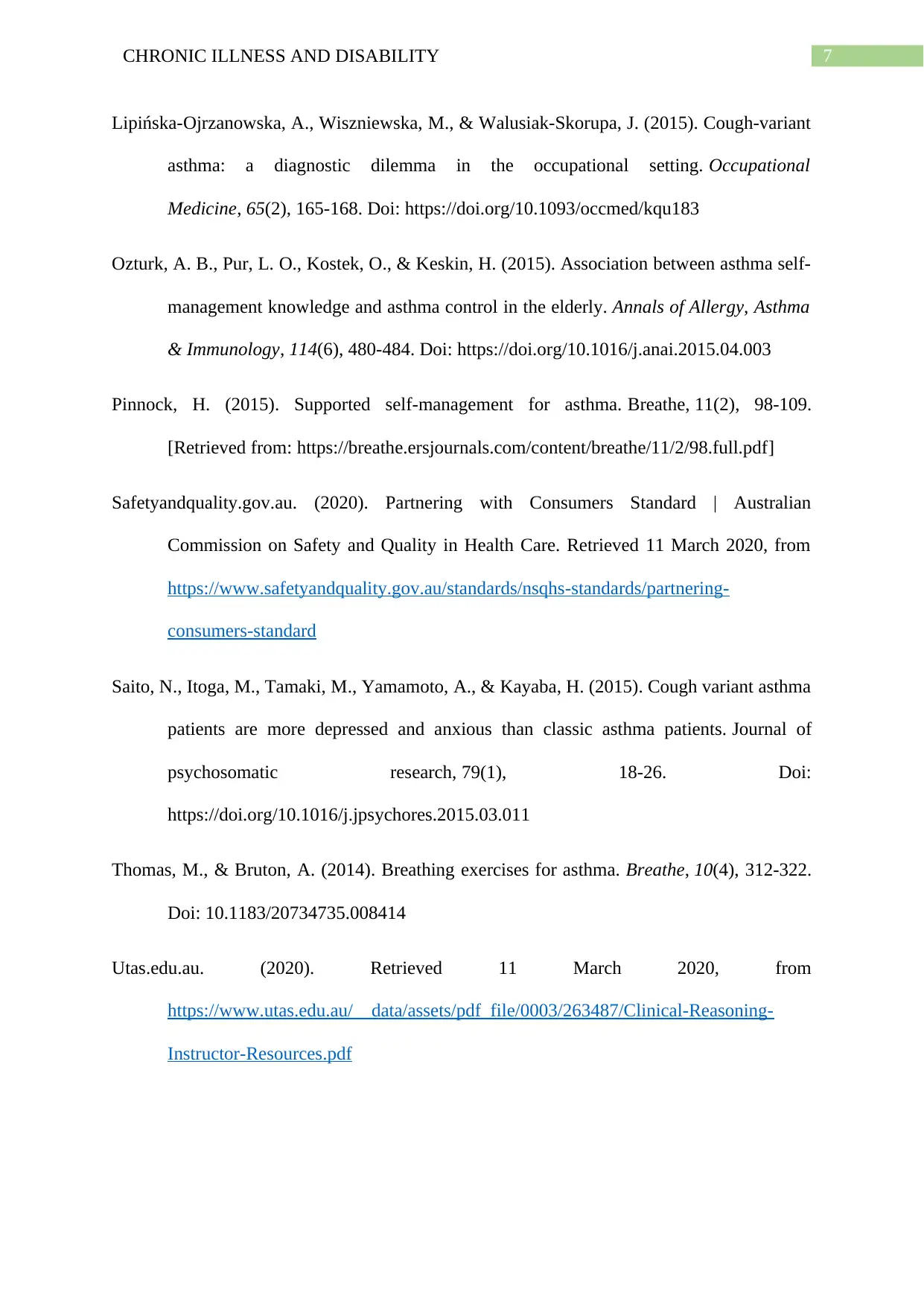
7CHRONIC ILLNESS AND DISABILITY
Lipińska-Ojrzanowska, A., Wiszniewska, M., & Walusiak-Skorupa, J. (2015). Cough-variant
asthma: a diagnostic dilemma in the occupational setting. Occupational
Medicine, 65(2), 165-168. Doi: https://doi.org/10.1093/occmed/kqu183
Ozturk, A. B., Pur, L. O., Kostek, O., & Keskin, H. (2015). Association between asthma self-
management knowledge and asthma control in the elderly. Annals of Allergy, Asthma
& Immunology, 114(6), 480-484. Doi: https://doi.org/10.1016/j.anai.2015.04.003
Pinnock, H. (2015). Supported self-management for asthma. Breathe, 11(2), 98-109.
[Retrieved from: https://breathe.ersjournals.com/content/breathe/11/2/98.full.pdf]
Safetyandquality.gov.au. (2020). Partnering with Consumers Standard | Australian
Commission on Safety and Quality in Health Care. Retrieved 11 March 2020, from
https://www.safetyandquality.gov.au/standards/nsqhs-standards/partnering-
consumers-standard
Saito, N., Itoga, M., Tamaki, M., Yamamoto, A., & Kayaba, H. (2015). Cough variant asthma
patients are more depressed and anxious than classic asthma patients. Journal of
psychosomatic research, 79(1), 18-26. Doi:
https://doi.org/10.1016/j.jpsychores.2015.03.011
Thomas, M., & Bruton, A. (2014). Breathing exercises for asthma. Breathe, 10(4), 312-322.
Doi: 10.1183/20734735.008414
Utas.edu.au. (2020). Retrieved 11 March 2020, from
https://www.utas.edu.au/__data/assets/pdf_file/0003/263487/Clinical-Reasoning-
Instructor-Resources.pdf
Lipińska-Ojrzanowska, A., Wiszniewska, M., & Walusiak-Skorupa, J. (2015). Cough-variant
asthma: a diagnostic dilemma in the occupational setting. Occupational
Medicine, 65(2), 165-168. Doi: https://doi.org/10.1093/occmed/kqu183
Ozturk, A. B., Pur, L. O., Kostek, O., & Keskin, H. (2015). Association between asthma self-
management knowledge and asthma control in the elderly. Annals of Allergy, Asthma
& Immunology, 114(6), 480-484. Doi: https://doi.org/10.1016/j.anai.2015.04.003
Pinnock, H. (2015). Supported self-management for asthma. Breathe, 11(2), 98-109.
[Retrieved from: https://breathe.ersjournals.com/content/breathe/11/2/98.full.pdf]
Safetyandquality.gov.au. (2020). Partnering with Consumers Standard | Australian
Commission on Safety and Quality in Health Care. Retrieved 11 March 2020, from
https://www.safetyandquality.gov.au/standards/nsqhs-standards/partnering-
consumers-standard
Saito, N., Itoga, M., Tamaki, M., Yamamoto, A., & Kayaba, H. (2015). Cough variant asthma
patients are more depressed and anxious than classic asthma patients. Journal of
psychosomatic research, 79(1), 18-26. Doi:
https://doi.org/10.1016/j.jpsychores.2015.03.011
Thomas, M., & Bruton, A. (2014). Breathing exercises for asthma. Breathe, 10(4), 312-322.
Doi: 10.1183/20734735.008414
Utas.edu.au. (2020). Retrieved 11 March 2020, from
https://www.utas.edu.au/__data/assets/pdf_file/0003/263487/Clinical-Reasoning-
Instructor-Resources.pdf
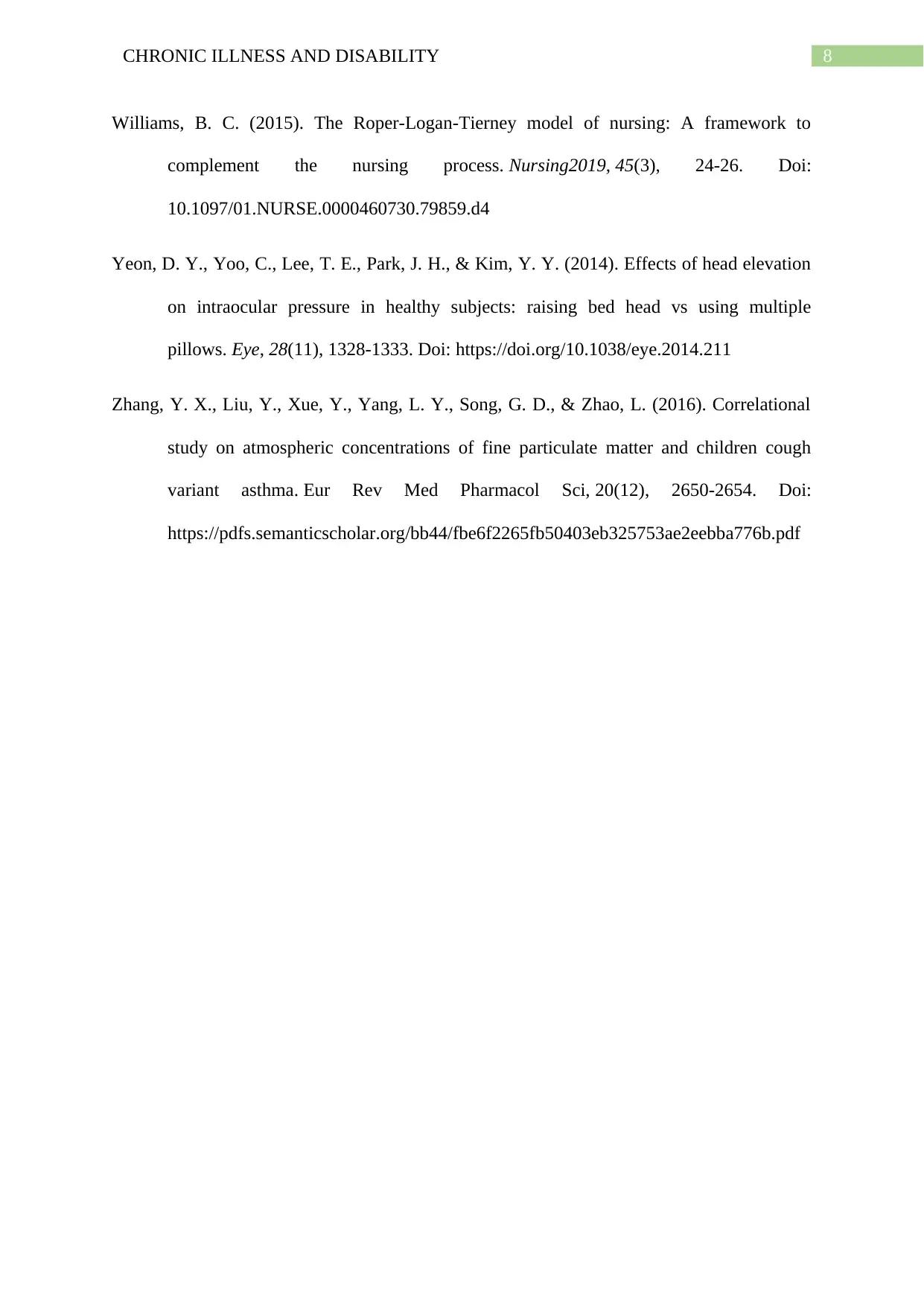
8CHRONIC ILLNESS AND DISABILITY
Williams, B. C. (2015). The Roper-Logan-Tierney model of nursing: A framework to
complement the nursing process. Nursing2019, 45(3), 24-26. Doi:
10.1097/01.NURSE.0000460730.79859.d4
Yeon, D. Y., Yoo, C., Lee, T. E., Park, J. H., & Kim, Y. Y. (2014). Effects of head elevation
on intraocular pressure in healthy subjects: raising bed head vs using multiple
pillows. Eye, 28(11), 1328-1333. Doi: https://doi.org/10.1038/eye.2014.211
Zhang, Y. X., Liu, Y., Xue, Y., Yang, L. Y., Song, G. D., & Zhao, L. (2016). Correlational
study on atmospheric concentrations of fine particulate matter and children cough
variant asthma. Eur Rev Med Pharmacol Sci, 20(12), 2650-2654. Doi:
https://pdfs.semanticscholar.org/bb44/fbe6f2265fb50403eb325753ae2eebba776b.pdf
Williams, B. C. (2015). The Roper-Logan-Tierney model of nursing: A framework to
complement the nursing process. Nursing2019, 45(3), 24-26. Doi:
10.1097/01.NURSE.0000460730.79859.d4
Yeon, D. Y., Yoo, C., Lee, T. E., Park, J. H., & Kim, Y. Y. (2014). Effects of head elevation
on intraocular pressure in healthy subjects: raising bed head vs using multiple
pillows. Eye, 28(11), 1328-1333. Doi: https://doi.org/10.1038/eye.2014.211
Zhang, Y. X., Liu, Y., Xue, Y., Yang, L. Y., Song, G. D., & Zhao, L. (2016). Correlational
study on atmospheric concentrations of fine particulate matter and children cough
variant asthma. Eur Rev Med Pharmacol Sci, 20(12), 2650-2654. Doi:
https://pdfs.semanticscholar.org/bb44/fbe6f2265fb50403eb325753ae2eebba776b.pdf
1 out of 9
Related Documents
Your All-in-One AI-Powered Toolkit for Academic Success.
+13062052269
info@desklib.com
Available 24*7 on WhatsApp / Email
![[object Object]](/_next/static/media/star-bottom.7253800d.svg)
Unlock your academic potential
© 2024 | Zucol Services PVT LTD | All rights reserved.





